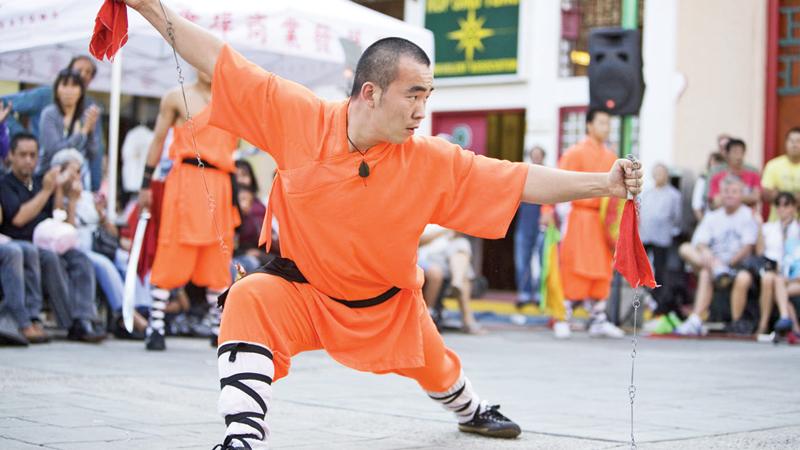
Traditional Chinese Martial arts or as it is more commonly known, Kung Fu, does not refer to any one martial art but to several hundreds of them developed over the course of China’s robust history spanning multiple centuries. Though collectively known as Kung Fu, a word meaning a skill learned or practised, they are also known as Wushu, literally martial art and Quanfa, literally fist method or law of the fist. Though these words are used to describe only Chinese martial arts, Japanese and Korean martial arts also tend to fall into this category as they are relatively indistinguishable from one another in the eyes of the west. While they share origins in self-defence; by choice or by being outdated, the uses for traditional martial arts have since far outgrown that purpose.
With a history as deep and rich as China itself, traditional martial arts are an irreplaceable part of Chinese culture and it perfectly captures the discipline and wisdom cultivated across centuries but while the stereotype that all Chinese know Kung Fu is unequivocally false, that heritage has a unique effect on the lifestyles of every Chinese citizen.
 However, as can be expected from such an ancient civilization, its exact history hasn’t been reliably documented and what records do exist can reasonably be expected to embellish events. What we can tell however, is that the Chinese developed martial arts out of a necessity to survive the violent hostile environments of ancient China. Predictably, hundreds of martial arts came into being with wildly different styles, beliefs and effectiveness and in a bid to achieve dominance, unbelievable tales of superhuman feats were woven and spread, giving these rivalling schools of fighting a mythic feel.
However, as can be expected from such an ancient civilization, its exact history hasn’t been reliably documented and what records do exist can reasonably be expected to embellish events. What we can tell however, is that the Chinese developed martial arts out of a necessity to survive the violent hostile environments of ancient China. Predictably, hundreds of martial arts came into being with wildly different styles, beliefs and effectiveness and in a bid to achieve dominance, unbelievable tales of superhuman feats were woven and spread, giving these rivalling schools of fighting a mythic feel.
In modern times, martial arts became optional and in turn what was once a form of self-defence adapted with the times, became a sport or performance art, relying on its centuries old history to attract students and maintain respect. Martial arts became a form of soft power for China much like K-Pop was for South Korea and anime for Japan, granting the nation global influence.
This aspect of Kung Fu has not only been noticed by the Chinese Government, but actively and enthusiastically promoted, even now funding the construction of thousands of new schools all over the country in just the past five years. The most popular of these schools of martial arts include household names such as Shaolin Kung Fu, Tai Chi and Wing Chun.
The explosive popularity Kung Fu movies and Wuxia tales have, simultaneously been both a great boon and bane to Chinese Martial Arts. Movies starring martial art actors like Bruce Lee and Jackie Chan spread the word of Kung Fu to foreign territories like wildfire and inspired interest in newer generations to come. However, the greatly romanticized representations and depictions of inhuman skill gave false expectations of what they were meant to be. Students would come to learn, expecting to leap hundreds of feet while dismantling hordes of opponents with their bare hands, only to be treated to days of practice and meditation to achieve the most basic of techniques.
In recent times, China has taken a most unusual stance, expressing the indisputable strength and superiority of their traditional martial arts over all else. This has led to a string of matches between martial art masters and more practical combat oriented fighting forms.
These fights have proven to be both highly publicized and humiliating, with MMA fighters beating masters into the ground in a matter of seconds. Fight after fight, the credibility of traditional martial arts as a form of self defence took quite the beating. While for many people globally this trend disillusioned them to the virtues of Kung Fu, China itself doubled down, insisting on its perfection and making ridiculous excuses on why those fights went down the way they did and unjustly punishing the true fighters who brought this truth to light, like MMA fighter Xu Xiadong who had his social credit score lowered and humiliated by both the nation and its people.
This isn’t to say there is no merit for traditional Chinese martial arts. Some martial artists have adapted their respective styles to adopt proven combat effective techniques to create a more practical form of their art, but these forward-thinking practitioners are a rare breed. However, while its use for combat may be questionable, its purpose as a tool for physical and spiritual betterment is unquestioned and its link and contributions to Chinese philosophy is significant. Practising these disciplines is undeniably beneficial to both your body and mind but it will not do to be blind to its faults.
